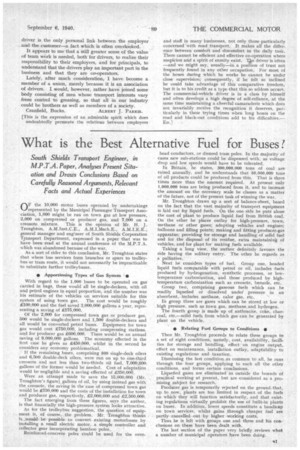What is the Best Alternative Fuel for Buses?
Page 19

If you've noticed an error in this article please click here to report it so we can fix it.
South Shields Transport Engineer, in M.P .T A. Paper, Analyses Present Situation and Draws Conclusions Based on Carefully Reasoned Arguments, Relevant Facts and Actual Experiences
(IF the 10,000 motor buses operated by undertakings ‘../represented by the Municipal Passenger Transport Association, 1,000 might be run on town gas at low pressure, 2,000 on compressed or producer gas, and 7,000 on a creosote mixture, This is the opinion of Mr. H, J. Troughton, A.M.Inst.C. E. , A.M . I.Mech . E. , A . M. I.E.E. , general manager and engineer of South Shields Corporation Transport Department, expressed in a paper that was to have been read at the annual conference of the M.P.T.A. which was abandoned because of the war.
As a sort of rider to this conclusion, Mr. Troughton states that where bus services form branches or spurs to trolleybus or tram route, it would not necessarily be impracticable to substitute further trolleybuses.
• Apportioning Types of Gas System • With regard to the 1,000 buses to be operated on gas carried in bags, these would all be single-deckers, with oil and petrol engines in equal proportion, and the number was his estimate of the vehicles on services suitable for this system of using town gas. The cost would be roughly £100,000 and the fuel saved 3,000,000 gallons a year, representing a saving of 211500.
• Of the 2,000 for compressed town gas or producer gas, 500 would be single-deckers and 1,500 double-deckers and all Would be converted petrol buses. Equipment for town gas would cost £750,000, including compressing stations, and for producer gas £600,000. There would be an annual saving of 9,000,000 gallons, The economy effected in the first case he gives as 4450,000, whilst in the second he considers any economy problematical.
' If the remaining buses, comprising 500 single-deck oilers and 6,500 double-deck oilers, were run on up to one-third creosote and not less than two-thirds oil fuel, 7,000,000 gallons of the former would be needed. Cost of adaptation would be negligible and a saving effected of £350,000.
Were an attempt made to save the 15,000,000 (Mr. Troughton's figure) gallons of oil, by using instead gas with the creosote, the saving in the case of compressed town gas would be £750,000 and the costs of the installation for town and producer gas, respectively, £2,000,000 and £2,500,000.
The fact emerging from these figures, says the author, is that financially the high-pressure system looks attractive.
As for the trolleybus suggestion, the question of equipment is, of course, the problem. Mr. Troughton thinks It .w.uuld be possible to convert existing motorbuses by installing a small electric motor, a simple controller and collector gear incorporating bamboo poles.
Reinforced-concrete poles could be used for the over head conductors, or disused tram poles. In the majority of cases new sub-stations could be dispensed with, as voltage drop and low speeds would have to be tolerated, In Britain, he states, 300,000,000 tons of coal are raised annually, and he understands that 50,000,000 tons of oil products could be produced from this. That is three times more than the amount required. At present only 1,000,000 tons are being produced from it, and to increase the amount on the necessary scale he classes as a matter of the future, not of the present task of winning the war.
Mr. Troughton draws up a sort of balance-sheet, based on the fact that the vast majority of transport equipment is laid out foF liquid fuels. On the one side he puts alone the cost of plant to produce liquid fuel from British coal. On the other he places outlay for high-pressure, town, methane or other gases; adapting vehicles and engines; balloons and filling points; making and fitting producer-gas apparatus; providing for storage and handling of solid fuel and for the disposal of its residue, extra maintaining of vehicles, and for plant for making fuels available.
Taking a long view, the author definitely favours the side having the solitary entry. The other he regards as a palliative.
Next he considers types of fuel. Group one, headed liquid fuels comparable with petrol or oil, includes fuels produced by hydrogenation, synthetic processes, or lowtemperature carbonization, and those produced by hightemperature carbonization such as creosote, benzole, etc.
Group two, comprising gaseous fuels which can be readily liquefied or dissolved under' pressure in an absorbent, includes methane, calor gas, etc.
In group three are gases which can be stored at low or high pressure, such as town gas, methane and hydrogen.
The fourth group is made up of anthracite, coke, charcoal, etc.—solid fuels from which gas can he generated by plant on the vehicle.
• Relating Fuel Groups to Conditions •
Then Mr. Troughton proceeds to relate these groups to a set of eight conditions, namely, cost, availability, facilities for storage and handling, effect on engine output, effect on maintenance, installation outlay, adaptability to existing regulations and taxation.
Dismissing the last condition as common to all, he runs through the four groups, applying to each all the other conditions, and forms certain conclusions.
Liquefied gases are eliminated as outside the bounds of practical working at present, but are considered as a promising subject for research.
Producer gas is temporarily rejected on the ground that, up to now, plants are too limited in respect of the fuels on which they will function satisfactorily, and that existing regulations virtually prohibit the use of built-in plants on buses. In addition, lower speeds constitute a handicap on town services, whilst gains through cheaper fuel are partly cancelled -out by higher working costs.
Thus he is left with groups one and three and his conclusions on these have been dealt with.
The last section of the paper very briefly reviews what a number of municipal operators have been doing.




















































